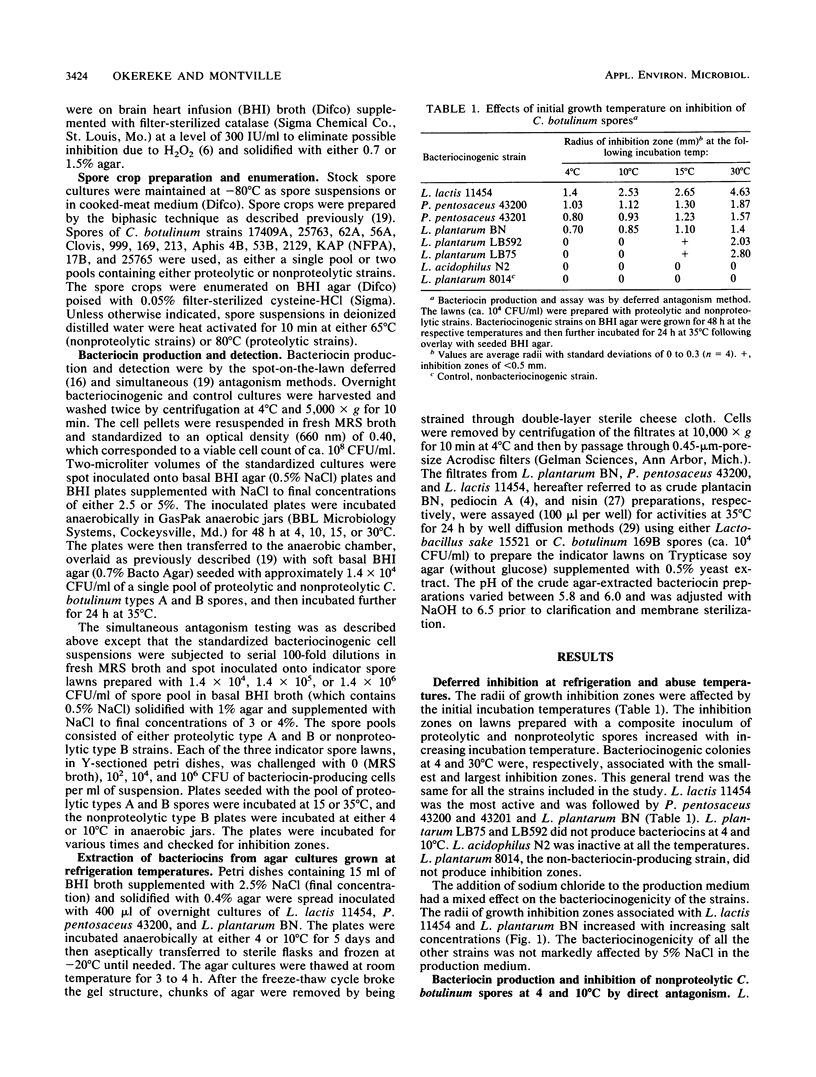Abstract
The bacteriocinogenicity of Lactococcus lactis ATCC 11454, Pediococcus pentosaceus ATCC 43200, P. pentosaceus ATCC 43201, Lactobacillus plantarum BN, L. plantarum LB592, L. plantarum LB75, and Lactobacillus acidophilus N2 against Clostridium botulinum spores at 4, 10, 15, and 35 degrees C was investigated by modified deferred and simultaneous antagonism methods. All the strains, except L. acidophilus N2, produced inhibition zones on lawns of C. botulinum spores at 30 degrees C. L. plantarum BN, L. lactis ATCC 11454, and P. pentosaceus ATCC 43200 and 43201 were bacteriocinogenic at 4, 10, and 15 degrees C. Supplementation of brain heart infusion agar with 0 to 5% NaCl increased the radii of inhibition zones during simultaneous antagonism assays. Detectable bacteriocin activities were extracted from freeze-thawed agar cultures of L. plantarum BN and L. lactis ATCC 11454 which had been grown at 4 and 10 degrees C. These results suggest that low levels of L. plantarum BN or L. lactis ATCC 11454, in the presence of 3 or 4% NaCl, could be formulated into minimally processed refrigerated food products for protection against possible botulism hazards.
Full text
PDF





Selected References
These references are in PubMed. This may not be the complete list of references from this article.
- BONVENTRE P. F., KEMPE L. L. Physiology of toxin production by Clostridium botulinum types A and B. III. Effect of pH and temperature during incubation on growth, autolysis. and toxin production. Appl Microbiol. 1959 Nov;7:374–377. doi: 10.1128/am.7.6.374-377.1959. [DOI] [PMC free article] [PubMed] [Google Scholar]
- Biswas S. R., Ray P., Johnson M. C., Ray B. Influence of Growth Conditions on the Production of a Bacteriocin, Pediocin AcH, by Pediococcus acidilactici H. Appl Environ Microbiol. 1991 Apr;57(4):1265–1267. doi: 10.1128/aem.57.4.1265-1267.1991. [DOI] [PMC free article] [PubMed] [Google Scholar]
- Daeschel M. A., Klaenhammer T. R. Association of a 13.6-Megadalton Plasmid in Pediococcus pentosaceus with Bacteriocin Activity. Appl Environ Microbiol. 1985 Dec;50(6):1538–1541. doi: 10.1128/aem.50.6.1538-1541.1985. [DOI] [PMC free article] [PubMed] [Google Scholar]
- Eklund M. W., Wieler D. I., Poysky F. T. Outgrowth and toxin production of nonproteolytic type B Clostridium botulinum at 3.3 to 5.6 C. J Bacteriol. 1967 Apr;93(4):1461–1462. doi: 10.1128/jb.93.4.1461-1462.1967. [DOI] [PMC free article] [PubMed] [Google Scholar]
- Fleming H. P., Etchells J. L., Costilow R. N. Microbial inhibition by an isolate of pediococcus from cucumber brines. Appl Microbiol. 1975 Dec;30(6):1040–1042. doi: 10.1128/am.30.6.1040-1042.1975. [DOI] [PMC free article] [PubMed] [Google Scholar]
- Geis A., Singh J., Teuber M. Potential of lactic streptococci to produce bacteriocin. Appl Environ Microbiol. 1983 Jan;45(1):205–211. doi: 10.1128/aem.45.1.205-211.1983. [DOI] [PMC free article] [PubMed] [Google Scholar]
- Gálvez A., Maqueda M., Martínez-Bueno M., Valdivia E. Bactericidal and bacteriolytic action of peptide antibiotic AS-48 against gram-positive and gram-negative bacteria and other organisms. Res Microbiol. 1989 Jan;140(1):57–68. doi: 10.1016/0923-2508(89)90060-0. [DOI] [PubMed] [Google Scholar]
- Hastings J. W., Stiles M. E. Antibiosis of Leuconostoc gelidum isolated from meat. J Appl Bacteriol. 1991 Feb;70(2):127–134. doi: 10.1111/j.1365-2672.1991.tb04438.x. [DOI] [PubMed] [Google Scholar]
- Klaenhammer T. R. Bacteriocins of lactic acid bacteria. Biochimie. 1988 Mar;70(3):337–349. doi: 10.1016/0300-9084(88)90206-4. [DOI] [PubMed] [Google Scholar]
- Lewus C. B., Kaiser A., Montville T. J. Inhibition of food-borne bacterial pathogens by bacteriocins from lactic acid bacteria isolated from meat. Appl Environ Microbiol. 1991 Jun;57(6):1683–1688. doi: 10.1128/aem.57.6.1683-1688.1991. [DOI] [PMC free article] [PubMed] [Google Scholar]
- MAYR-HARTING A. THE ADSORPTION OF COLICINE. J Pathol Bacteriol. 1964 Apr;87:255–266. doi: 10.1002/path.1700870206. [DOI] [PubMed] [Google Scholar]
- Schillinger U., Lücke F. K. Antibacterial activity of Lactobacillus sake isolated from meat. Appl Environ Microbiol. 1989 Aug;55(8):1901–1906. doi: 10.1128/aem.55.8.1901-1906.1989. [DOI] [PMC free article] [PubMed] [Google Scholar]
- Smith G. R., Young A. M. Clostridium botulinum in British soil. J Hyg (Lond) 1980 Oct;85(2):271–274. doi: 10.1017/s0022172400063300. [DOI] [PMC free article] [PubMed] [Google Scholar]
- Tagg J. R., Dajani A. S., Wannamaker L. W. Bacteriocins of gram-positive bacteria. Bacteriol Rev. 1976 Sep;40(3):722–756. doi: 10.1128/br.40.3.722-756.1976. [DOI] [PMC free article] [PubMed] [Google Scholar]
- Tagg J. R., McGiven A. R. Assay system for bacteriocins. Appl Microbiol. 1971 May;21(5):943–943. doi: 10.1128/am.21.5.943-943.1971. [DOI] [PMC free article] [PubMed] [Google Scholar]


